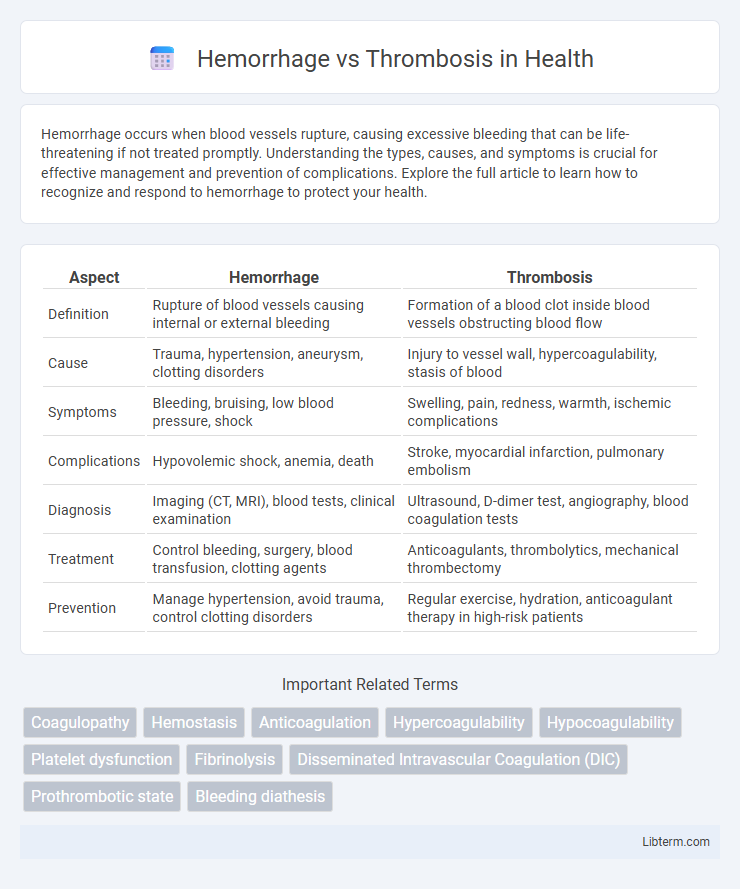Hemorrhage occurs when blood vessels rupture, causing excessive bleeding that can be life-threatening if not treated promptly. Understanding the types, causes, and symptoms is crucial for effective management and prevention of complications. Explore the full article to learn how to recognize and respond to hemorrhage to protect your health.
Table of Comparison
| Aspect | Hemorrhage | Thrombosis |
|---|---|---|
| Definition | Rupture of blood vessels causing internal or external bleeding | Formation of a blood clot inside blood vessels obstructing blood flow |
| Cause | Trauma, hypertension, aneurysm, clotting disorders | Injury to vessel wall, hypercoagulability, stasis of blood |
| Symptoms | Bleeding, bruising, low blood pressure, shock | Swelling, pain, redness, warmth, ischemic complications |
| Complications | Hypovolemic shock, anemia, death | Stroke, myocardial infarction, pulmonary embolism |
| Diagnosis | Imaging (CT, MRI), blood tests, clinical examination | Ultrasound, D-dimer test, angiography, blood coagulation tests |
| Treatment | Control bleeding, surgery, blood transfusion, clotting agents | Anticoagulants, thrombolytics, mechanical thrombectomy |
| Prevention | Manage hypertension, avoid trauma, control clotting disorders | Regular exercise, hydration, anticoagulant therapy in high-risk patients |
Introduction to Hemorrhage and Thrombosis
Hemorrhage is the pathological escape of blood from the vascular system, typically caused by vessel rupture or injury, leading to internal or external bleeding. Thrombosis involves the formation of a blood clot within a blood vessel, obstructing normal blood flow and potentially causing ischemia or infarction. Both conditions disrupt hemostatic balance, with hemorrhage representing bleeding excess and thrombosis reflecting abnormal clotting dynamics.
Definitions and Key Differences
Hemorrhage is the escape of blood from a ruptured blood vessel leading to excessive bleeding, while thrombosis refers to the formation of a blood clot inside a blood vessel, obstructing blood flow. The key difference lies in hemorrhage involving blood loss outside vessels, whereas thrombosis involves clot formation within vessels causing vascular blockage. Understanding these conditions is critical for diagnosing and managing vascular disorders effectively.
Causes of Hemorrhage
Hemorrhage occurs due to trauma, vascular abnormalities, or coagulation disorders, which disrupt blood vessel integrity and cause blood to escape into surrounding tissues. Conditions like hypertension, aneurysms, and platelet dysfunction also contribute to spontaneous bleeding. In contrast, thrombosis involves abnormal blood clot formation within vessels, often triggered by endothelial injury, stasis, or hypercoagulability.
Causes of Thrombosis
Thrombosis primarily results from endothelial injury, altered blood flow, and hypercoagulability, collectively known as Virchow's triad. Common causes include atherosclerosis, vessel trauma, prolonged immobility, and genetic clotting disorders such as Factor V Leiden mutation. These factors promote abnormal clot formation within blood vessels, leading to vascular obstruction and increased risk of ischemic events.
Clinical Manifestations
Hemorrhage clinically presents with symptoms such as sudden bruising, petechiae, hematomas, and prolonged bleeding from minor injuries, often accompanied by hypotension and tachycardia in severe cases. Thrombosis manifests with localized pain, swelling, redness, and warmth, reflecting impaired blood flow and potential tissue ischemia; venous thrombosis may cause limb edema while arterial thrombosis risks organ infarction. Diagnostic evaluation includes laboratory tests like coagulation profiles and imaging modalities such as Doppler ultrasound or CT angiography to identify bleeding sites or thrombus location.
Diagnostic Approaches
Hemorrhage and thrombosis require distinct diagnostic approaches for accurate differentiation and management. Imaging techniques such as CT scans and MRI are crucial for identifying hemorrhages by visualizing active bleeding or hematomas, while Doppler ultrasound and venography help detect thrombi by assessing blood flow and vessel patency. Laboratory tests including coagulation profiles (PT, aPTT, platelet count) provide essential information to evaluate bleeding risk or clotting disorders, guiding targeted treatment strategies.
Risk Factors and Predispositions
Hemorrhage risk factors include hypertension, anticoagulant therapy, trauma, and vascular malformations such as arteriovenous malformations or aneurysms. Thrombosis is commonly predisposed by conditions like prolonged immobility, cancer, inherited clotting disorders (e.g., Factor V Leiden), and atrial fibrillation, which promotes blood stasis. Both conditions share risk factors such as obesity, smoking, and advanced age, but their pathophysiological mechanisms differ, with hemorrhage involving vessel rupture and thrombosis involving pathological clot formation.
Complications and Consequences
Hemorrhage leads to complications such as hypovolemic shock, organ failure, and increased intracranial pressure, causing tissue ischemia and potential death. Thrombosis results in vascular obstruction, risking ischemic stroke, myocardial infarction, and deep vein thrombosis with pulmonary embolism as a critical consequence. Both conditions disrupt normal blood flow, leading to severe systemic impacts requiring prompt diagnosis and treatment.
Treatment and Management Strategies
Hemorrhage treatment centers on rapid blood loss control using methods such as direct pressure, fluid resuscitation with crystalloids or blood products, and surgical intervention when necessary. Thrombosis management involves anticoagulant medications like heparin or warfarin to prevent clot extension and thrombolytic therapy in acute cases, alongside mechanical thrombectomy in severe instances. Both conditions require continuous monitoring of coagulation parameters and tailored therapy to balance bleeding risk against thrombosis prevention.
Prevention and Prognosis
Hemorrhage prevention centers on controlling blood pressure, avoiding anticoagulant overdose, and managing trauma risks, while thrombosis prevention emphasizes vascular health through anticoagulants, antiplatelet therapy, and lifestyle modifications such as smoking cessation and regular exercise. Prognosis for hemorrhage depends on the hemorrhage site and volume, with rapid intervention critical to reduce morbidity and mortality. Thrombosis prognosis improves with early detection and treatment, as timely anticoagulation reduces complications like stroke, pulmonary embolism, and post-thrombotic syndrome.
Hemorrhage Infographic

 libterm.com
libterm.com